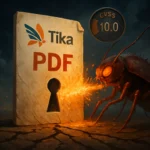A newly disclosed flaw in the popular WordPress performance plugin W3 Total Cache exposes over a million websites to a critical remote code execution (RCE) risk. Tracked as CVE-2025-9501, the vulnerability allows attackers to execute arbitrary PHP code on the server without any authentication, using nothing more than a specially crafted comment.
What is CVE-2025-9501 in the W3 Total Cache plugin?
The vulnerability affects all W3 Total Cache versions up to and including 2.8.13. The root cause lies in how the plugin processes so‑called “dynamic functions” in cached HTML. The issue is specifically related to the internal function _parse_dynamic_mfunc(), which is responsible for parsing and handling dynamic content within cached pages.
According to analysis by WPScan, an attacker can inject a malicious payload into content that W3 Total Cache later interprets as PHP code. Under certain conditions, when this content is parsed by the vulnerable function, the plugin will treat the attacker‑controlled data as executable PHP, leading to complete code execution on the server.
In practice, the attacker only needs a way to submit content to the site—most commonly via the WordPress comments system. A crafted comment becomes the delivery mechanism for the exploit, turning a basic user interaction feature into a high‑impact attack vector.
Unauthenticated remote code execution via WordPress comments
From a security perspective, CVE-2025-9501 is a classic unauthenticated RCE vulnerability. Unlike many WordPress attacks that require a valid user account, stolen credentials or bypass of multifactor authentication, this flaw can be exploited by anyone who is able to post a comment on the site.
Once successful, the attacker effectively gains the ability to run arbitrary PHP on the underlying web server. This level of access typically allows an intruder to:
- Deploy persistent web shells and backdoors for long‑term control;
- Modify or replace core, theme and plugin files to insert malware or defacements;
- Create, escalate or delete administrator accounts in WordPress;
- Inject phishing pages or malicious redirects to monetize traffic;
- Enlist the server into botnets or use it for spam and further attacks.
Such scenarios are consistent with patterns observed in previous high‑profile WordPress plugin vulnerabilities, where automated exploit campaigns rapidly target unpatched sites once exploit code becomes widely available.
Scale of exposure: over one million WordPress sites at risk
W3 Total Cache is one of the most widely used optimization plugins in the WordPress ecosystem, with over 1 million active installations according to the WordPress.org plugin directory. Given that WordPress itself powers more than 40% of all websites globally, a critical flaw in such a popular plugin represents a substantial attack surface.
The vendor released a fix in version 2.8.13 on 20 October 2025, addressing the vulnerable dynamic function parsing logic. However, WordPress.org download statistics indicate roughly 430,000 downloads since the patch release, implying that a large number of installations remain outdated and therefore exploitable.
This lag in patch adoption is a recurring issue in the WordPress ecosystem: plugins may be updated promptly by developers, but operational or organizational delays on the administrator side often leave systems exposed for weeks or months.
Exploit availability and the limited response window
WPScan researchers have already prepared a proof-of-concept (PoC) exploit that demonstrates how CVE-2025-9501 can be triggered in real conditions. In line with responsible disclosure practices, they have delayed public release of the PoC until 24 November 2025, providing administrators with a short but valuable window to patch their sites.
Historical data across the industry shows that once PoC code is published, malicious actors often automate large‑scale internet scans within days. In this case, the exploit’s simplicity—leveraging comments as the delivery channel—makes mass exploitation campaigns especially feasible for both skilled and low‑skill attackers.
How to protect WordPress sites from CVE-2025-9501
1. Immediately update W3 Total Cache to a safe version
The primary mitigation step is to update W3 Total Cache to version 2.8.13 or later, where the vulnerability has been patched. The update should be performed via the official WordPress repository or directly from the WordPress admin dashboard, ideally after creating a full backup of both files and the database.
2. Temporarily disable W3 Total Cache if you cannot update
If immediate updating is not possible—for example, due to strict compatibility requirements with legacy themes or custom integrations—administrators should deactivate W3 Total Cache until the new version can be safely tested in a staging environment.
3. Reduce risk by hardening the WordPress comment system
Because the current exploitation vector relies on comments, site owners should consider tightening comment controls while rolling out patches. Recommended measures include:
- Temporarily disabling comments on public posts or critical sections;
- Enforcing strict pre‑moderation of all new comments;
- Disallowing anonymous comments and requiring user registration;
- Using anti‑spam and content filtering tools to block suspicious payloads;
- Restricting allowed HTML in comments to a minimal, safe subset.
4. Strengthen overall WordPress security hygiene
CVE-2025-9501 illustrates how performance and caching plugins can become critical attack entry points. To reduce exposure to similar issues, administrators should:
- Regularly update WordPress core, themes and all plugins;
- Remove unused plugins and themes rather than simply deactivating them;
- Deploy a Web Application Firewall (WAF) or security plugin tuned for WordPress;
- Monitor server and application logs for suspicious activity and configure alerts.
CVE-2025-9501 in W3 Total Cache underscores how a single flaw in a widely deployed plugin can endanger hundreds of thousands of sites at once. Rapid patching, temporary hardening of high‑risk features such as comments, and disciplined update practices significantly reduce the likelihood of compromise. Organizations that treat plugin management and regular security audits as core maintenance tasks, rather than optional extras, are far better positioned to withstand the next wave of WordPress‑targeted exploits.






